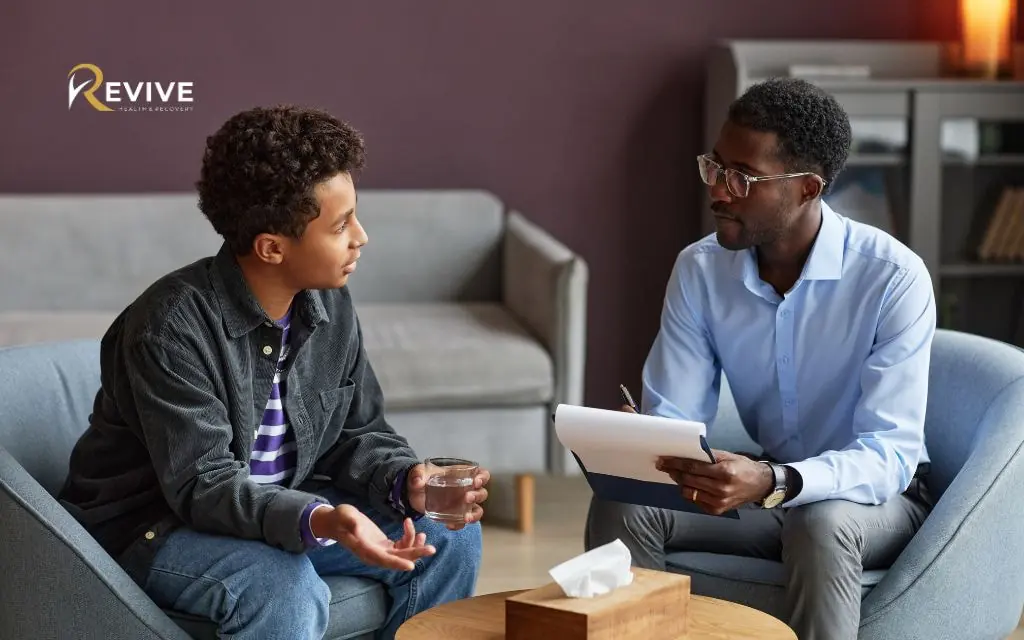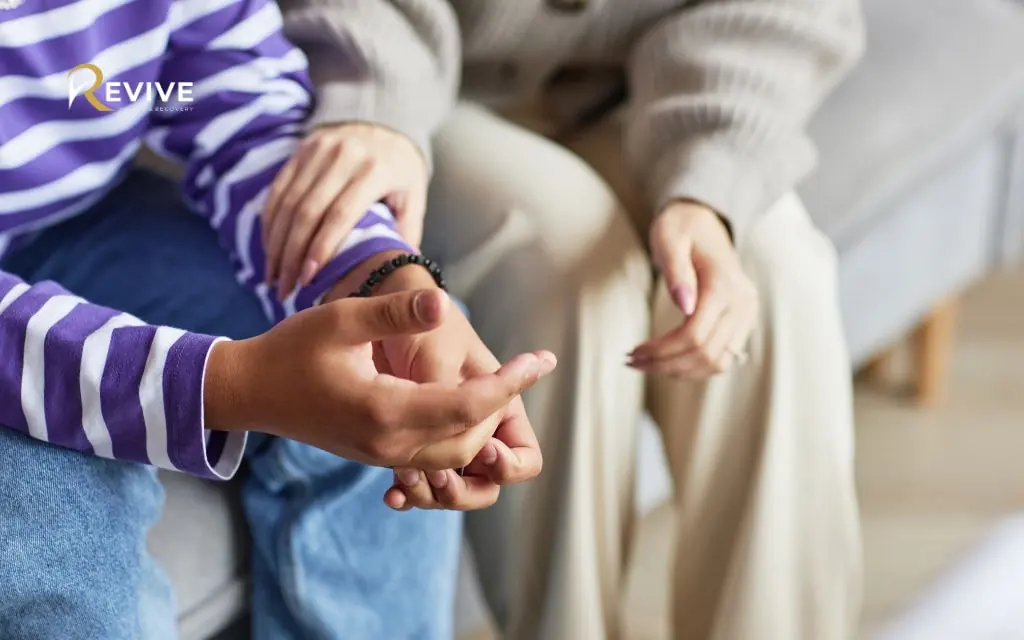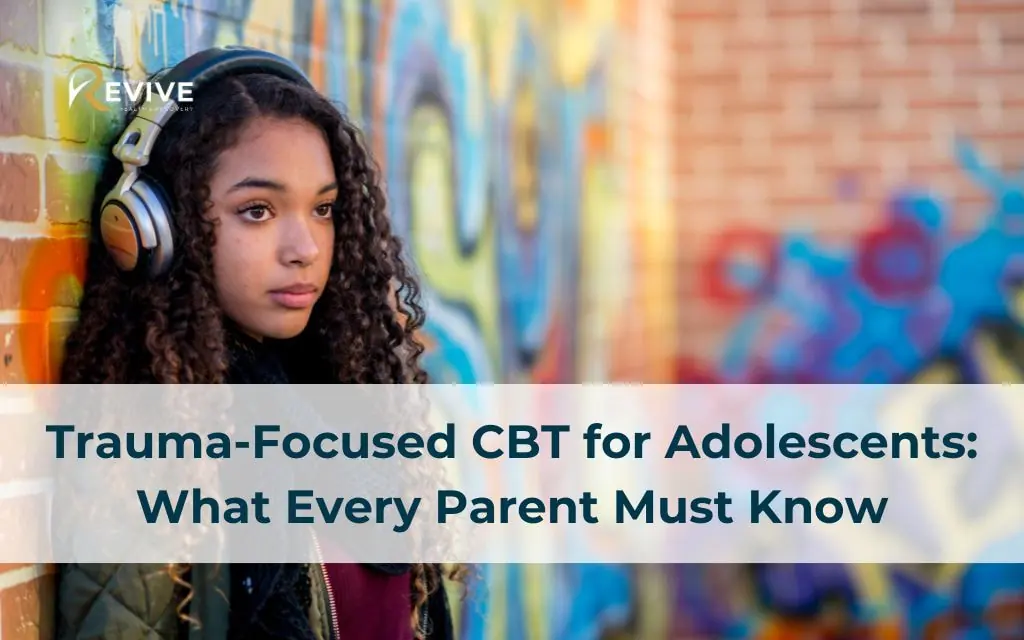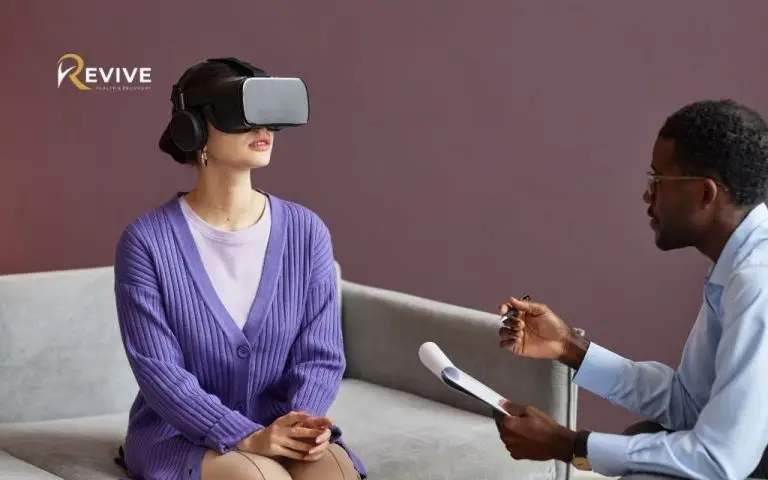Trauma-focused CBT for adolescents (TF-CBT) represents a specialized treatment approach designed specifically for adolescents who have experienced trauma. Unlike general therapy methods, TF-CBT addresses the unique cognitive, emotional, and developmental needs of young people navigating trauma recovery.
At Revive Health Recovery, we recognize that adolescents process traumatic experiences differently than adults. Their developing brains require interventions that account for ongoing neurological growth while addressing the immediate effects of trauma. TF-CBT stands as the premier evidence-based cognitive behavioral therapy for traumatized youth, recognized by the American Psychological Association and the Society for Clinical Child and Adolescent Psychology.
What is Trauma-Focused Cognitive Behavioral Therapy (TF-CBT)?
Early intervention proves critical for adolescent trauma recovery. Research shows that untreated trauma can lead to long-term mental health issues, academic problems, relationship difficulties, and increased risk of substance use. Timely TF-CBT intervention creates neural pathways toward resilience rather than dysfunction.
Trauma-focused CBT for adolescents operates on core principles that distinguish it from traditional cognitive behavioral therapy for teens, as outlined in this overview of TF-CBT from Psychology Today. While standard CBT works primarily with current thought patterns, TF-CBT specifically targets traumatic experiences and their aftermath. This specialized therapy integrates trauma-sensitive practices with cognitive restructuring techniques.
The approach incorporates several foundational objectives:
- Processing traumatic memories safely
- Developing coping skills for trauma triggers
- Restructuring unhelpful beliefs stemming from trauma
- Improving family communication about trauma
- Enhancing safety planning and future resilience
Licensed TF-CBT therapists undergo specialized training beyond standard mental health credentials. They master trauma-specific assessment tools, safety protocols, and evidence-based interventions designed for adolescents. This expertise enables them to navigate the complex intersection of trauma, adolescent development, and healing.
Eligibility criteria for TF-CBT typically include:
- Ages 3-18 (with adaptations for developmental stage)
- Experience of identifiable traumatic event(s)
- Presence of trauma symptoms (not necessarily full PTSD)
- Availability of a non-offending caregiver for participation
- Absence of acute safety concerns or severe psychiatric instability

How Does Trauma-Focused CBT Help Adolescents?
What is adolescent trauma?
Adolescent trauma encompasses adverse experiences that overwhelm a young person’s ability to cope and create a sense of helplessness or terror. Common causes, detailed further by the National Child Traumatic Stress Network as common causes of child and adolescent trauma, include:
- Physical or sexual abuse
- Witnessing domestic or community violence
- Serious accidents or injuries
- Bullying or social victimization
- Natural disasters or public emergencies
- Loss of a loved one through traumatic circumstances
- Medical trauma
Effects of trauma on adolescent brain development
Trauma significantly impacts adolescent brain development, as explored in detail by the Child Mind Institute on trauma’s effects on the adolescent brain. The adolescent brain undergoes substantial remodeling, particularly in areas responsible for executive function, emotional regulation, and risk assessment. Trauma during this period can:
- Disrupt prefrontal cortex development, affecting decision-making
- Sensitize the amygdala, creating heightened stress responses
- Alter hippocampal function, affecting memory formation
- Influence reward pathway development, potentially increasing vulnerability to substance use
- Impact the HPA axis, affecting stress hormone regulation
Research by neuroscientists like Dr. David DeGarmo demonstrates that trauma-focused interventions can help redirect these neurological impacts, supporting healthier brain development despite trauma exposure.
Signs and symptoms of unresolved trauma in teenagers
Unresolved trauma manifests differently in adolescents than in adults. Common indicators include:
- Behavioral changes: risk-taking, aggression, withdrawal
- Academic decline or school avoidance
- Sleep disturbances and nightmares
- Somatic complaints (headaches, stomachaches)
- Heightened startle response
- Emotional volatility or numbness
- Substance experimentation
- Self-harm behaviors
- Relationship difficulties
- Trauma reenactment
Scientific Research And Reviews Of Trauma-Focused Cbt For Adolescents
Multiple randomized controlled trials demonstrate TF-CBT’s effectiveness for adolescents. A meta-analysis on TF-CBT effectiveness published in the Journal of Clinical Child & Adolescent Psychology found trauma-focused CBT for adolescents significantly reduced PTSD symptoms, depression, and behavioral problems compared to waitlist controls or alternative treatments.
The National Child Traumatic Stress Network designates TF-CBT as having the strongest research evidence among youth trauma therapy options. Studies show that 80% of adolescents who complete TF-CBT no longer meet criteria for PTSD, with improvements maintained at 1-year follow-up.
The 8 Core Components of TF-CBT for Adolescents
1. Psychoeducation
Psychoeducation forms the foundation of TF-CBT by providing factual information about trauma and its effects. This component:
- Normalizes trauma responses, helping teens understand their reactions are natural
- Explains the brain’s response to threat and danger
- Dispels myths about trauma that may fuel self-blame
- Creates a shared language between teen, therapist, and caregivers
- Introduces the concept of trauma triggers and responses
Psychoeducation empowers adolescents by transforming confusing experiences into understandable processes, reducing self-stigma and isolation.
2. Parent/Caregiver Involvement
The involvement of non-offending caregivers substantially enhances TF-CBT effectiveness. This component includes:
- Parallel sessions where caregivers learn the same skills as their teens
- Joint sessions for practicing communication and coping strategies
- Guidance on managing trauma-related behaviors at home
- Tools for responding supportively to trauma disclosures
- Strategies for balancing independence with safety concerns
Research demonstrates that caregiver participation doubles the treatment effects compared to adolescent-only interventions.

3. Relaxation Techniques
Trauma disrupts the nervous system’s regulation. trauma-focused CBT for adolescents teaches relaxation techniques including:
- Diaphragmatic breathing calibrated for teenage users
- Progressive muscle relaxation adapted for different settings
- Mindfulness practices focused on present-moment awareness
- Guided imagery for safe mental escape during triggers
- Body-based grounding techniques
These skills, along with practices like yoga for stress relief, help adolescents regain control over physiological stress responses, creating immediate relief and building long-term self-regulation abilities.
4. Affective Expression and Regulation
Many traumatized adolescents struggle with identifying, expressing, and managing emotions. This component addresses these challenges through:
- Emotional vocabulary development beyond “fine” or “whatever”
- Recognition of bodily cues signaling emotional states
- Healthy expression channels for intense emotions like anger or shame, which can also be supported through complementary approaches like art therapy for trauma survivors, offering creative outlets for emotional release.
- Emotion modulation techniques for overwhelming feelings
- Strategies for communicating emotional needs to others
These skills transform emotion from an overwhelming force to an informative experience that guides rather than controls behavior.
5. Cognitive Coping and Restructuring
Trauma often creates distorted beliefs about self, others, and the world. This component works to:
- Identify unhelpful thought patterns resulting from trauma
- Examine the connection between thoughts, feelings, and behaviors
- Challenge catastrophic thinking and negative self-views
- Develop more balanced perceptions of traumatic experiences, an approach that shares similarities with cognitive processing therapy for childhood trauma, which also targets trauma-related beliefs.
- Build nuanced thinking rather than black-and-white views
This cognitive work creates psychological flexibility, allowing adolescents to interpret their experiences in ways that promote healing rather than continued suffering.
6. Trauma Narrative and Processing
Creating a trauma narrative represents a cornerstone of trauma-focused CBT for adolescents. This structured approach involves:
- Gradual creation of a written, verbal, or creative account of traumatic experiences, a process that can be enhanced by exploring art therapy as a tool for trauma recovery, which uses creative expression to deepen narrative work.
- Progressive exposure to reduce emotional activation during trauma recall
- Identification of trauma-related cognitive distortions
- Integration of the trauma into the adolescent’s broader life story
- Optional sharing of the narrative with supportive caregivers
This process transforms fragmented, emotionally overwhelming memories into coherent narratives that adolescents can control rather than being controlled by.
7. In Vivo Exposure
For many traumatized adolescents, avoidance behaviors limit normal development. In vivo exposure addresses this through:
- Gradual, controlled exposure to trauma reminders that aren’t actually dangerous
- Hierarchical approach beginning with minimally triggering situations
- Real-world practice of coping skills during exposure exercises
- Reinforcement of safety distinctions between past and present
- Reclaiming of activities abandoned due to trauma associations
This component helps adolescents distinguish between real danger and trauma reminders, expanding their world when avoidance has narrowed it.
8. Enhancing Safety, Growth, and Future Development
The final component transitions from trauma processing to future resilience through:
- Comprehensive safety planning for potential dangers
- Development of healthy relationship boundaries
- Application of trauma lessons to future challenges
- Identification of ongoing support resources
- Celebration of growth and therapeutic achievements
This forward-looking focus helps adolescents move beyond a trauma-defined identity toward continued growth and development.
The Effectiveness of TF-CBT for Adolescents
TF-CBT demonstrates superior outcomes compared to other adolescent trauma treatments. Multiple studies show trauma-focused CBT for adolescents outperforms supportive therapy, child-centered therapy, and standard community care for traumatized youth.
Research tracking adolescents through TF-CBT shows significant improvements in:
- PTSD symptom reduction (70-80% improvement)
- Depression (50-60% symptom reduction)
- Anxiety (40-50% symptom reduction)
- Externalizing behaviors (45% reduction)
- Suicidal ideation (65% reduction)
Long-term benefits of trauma-focused CBT for adolescents extend beyond symptom reduction. Follow-up studies reveal improvements in:
- Academic performance and school engagement
- Family relationships and communication
- Peer relationship quality
- Risk-taking behavior reduction
- Substance use prevention
- Future resilience when facing challenges
These outcomes demonstrate TF-CBT’s capacity to not only address immediate trauma symptoms but to change developmental trajectories toward healthier futures.
Step-by-Step Process of TF-CBT Treatment for Adolescents
TF-CBT typically spans 12-20 weekly sessions, each lasting 60-90 minutes. The structure follows three phases:
- Stabilization and Skill Building (Sessions 1-4)
- Safety assessment and treatment planning
- Psychoeducation about trauma and therapy
- Introduction of relaxation and emotion regulation skills
- Beginning cognitive work and caregiver coaching
- Trauma Narrative and Processing (Sessions 5-12)
- Gradual development of the trauma narrative
- Processing of challenging trauma moments
- Cognitive restructuring of trauma-related beliefs
- Preparation for sharing narrative with caregivers
- Integration and Consolidation (Sessions 13-20)
- Joint sessions for narrative sharing when appropriate
- In vivo exposure to overcome avoidance
- Safety planning and future skill application
- Relapse prevention and transition planning

A typical session includes:
- Check-in and review of the previous week
- Review of home practice assignments
- Introduction or continuation of component work
- Skill practice and feedback
- Assignment of home practice
- Session summary and preview of next steps
Homework forms an essential part of TF-CBT, including:
- Practicing relaxation techniques between sessions
- Tracking thoughts, feelings, and behaviors
- Gradual exposure exercises
- Caregiver-adolescent communication practice
- Journal writing or narrative development
This structured approach ensures consistent progress while allowing flexibility to address emerging needs or challenges.
Challenges and Considerations in TF-CBT for Adolescents
Resistance to Treatment
Treatment resistance appears commonly in adolescent mental health treatment for several reasons:
- Developmental drive for autonomy and independence
- Fear of confronting painful trauma memories
- Skepticism about therapy effectiveness
- Concern about caregiver involvement
- Avoidance as an established coping strategy
Effective approaches to resistance include:
- Motivational interviewing techniques
- Clear explanation of treatment rationale
- Collaborative goal setting that aligns with teen priorities
- Flexible pacing that respects readiness
- Technology integration that appeals to adolescent interests
Cultural Adaptations
TF-CBT requires cultural tailoring to ensure effectiveness across diverse populations:
- Language adaptations beyond simple translation
- Integration of cultural values and strengths
- Modification of examples to reflect cultural experiences
- Inclusion of cultural healing practices when appropriate
- Consultation with cultural leaders or experts
Research demonstrates that culturally-adapted trauma-focused CBT for adolescents maintains or improves outcomes compared to standard delivery.
Co-occurring Disorders
Many traumatized adolescents present with additional mental health challenges:
- Depression requiring safety monitoring and mood interventions
- Anxiety disorders that may intensify during trauma processing
- Substance use as self-medication for trauma symptoms
- ADHD complicating skill learning and implementation
- Conduct problems affecting therapeutic engagement
TF-CBT can address these co-occurring conditions through:
- Integrated treatment approaches
- Modified pacing to accommodate multiple needs
- Coordination with psychiatry for medication management
- Additional skill modules specific to co-occurring conditions
- Extended treatment duration when necessary
How to Find a TF-CBT Therapist for Adolescents in Denver
Credentials and Qualifications
When seeking a qualified TF-CBT therapist for adolescents in Denver, look for:
- Master’s or doctoral degree in psychology, counseling, or social work
- State licensure in their professional discipline
- Specific TF-CBT certification or training verification
- Experience working with adolescents (not just adults)
- Specialized trauma training beyond basic TF-CBT
At Revive Health Recovery in Denver, our trauma specialists maintain current certification in TF-CBT and undergo continuous education in adolescent trauma treatment.
Questions to Ask Potential Therapists
Important questions to ask when interviewing potential therapists include:
- “What specific training have you received in TF-CBT?”
- “How many adolescents have you treated using this approach?”
- “How will you involve me as a parent/caregiver in the process?”
- “How do you handle crisis situations if they arise?”
- “What outcome measures do you use to track progress?”
- “How do you adapt the approach for my teen’s specific needs?”
Online vs. In-Person Therapy Options
Both delivery methods offer advantages:
In-Person TF-CBT:
- Facilitates direct observation of non-verbal cues
- Provides controlled environment for trauma processing
- Eliminates technology barriers
- May feel more supportive during intense emotional work
- Easier implementation of experiential techniques
Online TF-CBT:
- Eliminates transportation barriers
- Offers treatment access in underserved areas
- May feel safer for highly anxious adolescents
- Allows therapy participation from familiar environment
- Can incorporate digital tools familiar to adolescents
Research demonstrates comparable effectiveness between properly conducted telehealth and in-person TF-CBT.
Cost of Trauma-Focused CBT for Adolescents in Denver
The cost of trauma-focused CBT for adolescents in Denver varies based on provider type and insurance coverage such as private practice therapists, community mental health centers, hospital-affiliated programs or group practice settings.
At Revive Health Recovery, we accept some major insurance plans (Please call us for more infomation). Our intake coordinators provide transparent cost information and verification of benefits before treatment begins.
Many Denver families qualify for additional support through:
- Colorado’s Child Health Plan Plus
- Victim compensation funds for crime-related trauma
- School-based service partnerships
- Grant-funded treatment slots for qualifying families
Investment in TF-CBT represents significant value considering the long-term costs of untreated trauma, including potential future mental health treatment, academic interventions, and substance use treatment.
Frequently Asked Questions (FAQs)
How long does TF-CBT take to work for adolescents?
Most adolescents see improvement by sessions 6-8, with substantial gains by completion (sessions 12-20). Research shows 80% no longer meet PTSD criteria after completing the protocol. Timeline varies based on trauma complexity, pre-existing conditions, caregiver involvement, and treatment consistency.
Can TF-CBT help with PTSD in teens?
TF-CBT is the gold standard for adolescent PTSD treatment with the strongest evidence base among youth trauma therapies. It effectively addresses intrusive memories, hypervigilance, avoidance behaviors, emotional numbing, and trauma-related thought patterns.
Is TF-CBT covered by insurance?
Most insurance plans cover TF-CBT as an evidence-based treatment, including Medicaid (100% coverage), commercial insurance, Colorado state employee plans, and most employer-sponsored plans. Revive Health Recovery verifies benefits before treatment begins.
How can parents support their child through TF-CBT?
Parents support success by attending parent sessions, practicing skills between appointments, creating a supportive home environment, learning trauma-informed parenting strategies, and maintaining open communication with the therapist.
What are the risks or side effects of TF-CBT?
Minimal risks include temporary distress during trauma processing, initial resistance, and family system adjustments. These are managed through gradual exposure, skill building before trauma processing, clear communication, and ongoing safety monitoring.
How to Start Trauma-Focused CBT for Adolescents at Revive Health Recovery
Starting treatment involves seven steps: initial consultation (303-268-4655), comprehensive assessment, treatment planning, insurance verification, therapist matching, orientation to the approach, and beginning weekly sessions. Our Denver location provides a safe environment with flexible scheduling to accommodate school and family needs.
Conclusion
Trauma-focused CBT for adolescents in Denver offers a scientifically validated path to recovery from trauma. Through its structured, comprehensive approach, TF-CBT addresses both the immediate symptoms of trauma and its deeper impacts on development, identity, and relationships.
At Revive Health Recovery in Denver, we witness daily how this powerful intervention transforms the lives of traumatized youth. Our specialized team provides this evidence-based treatment with Trauma Informed Care and the commitment needed to guide adolescents from trauma to resilience.
If your adolescent shows signs of trauma impact, early intervention through TF-CBT can change their developmental trajectory. Contact Revive Health Recovery at (303) 268-4655 to learn more about our adolescent trauma services or to schedule an initial consultation.



